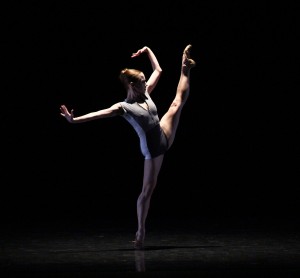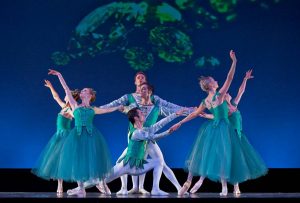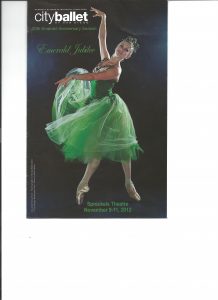City Ballet looks good at 20, but not after 10 pm

Ariana Samuelsson in “Infinitus Terminus,” a new dance by Geoffrey Gonzalez. Photo credit: Chelsea Penyak
What does the future hold for City Ballet of San Diego? Could this admirable company celebrating its 20th anniversary take a big leap forward? Instead of restaging tired antique ballets, could it continue to build its contemporary repertory? And if it tapped into adventurous new choreographers who push boundaries, wouldn’t the outcomes be more compelling for both dancers and audience?
Yes, was the resounding answer to those questions when City Ballet opened its emerald anniversary season at the Spreckels Theatre last weekend. The dances that bounced from the 1960s to deluxe contemporary, and then plunged into the mid-1800s served as a pleasing history lesson and peek into the future.
The program of four dances began with the sparkling company premiere of George Balanchine’s “Emeralds,” one of three ballets from “Jewels” (1967), considered the first full-length abstract ballet.
“Emeralds” is an ode to Romantic ballets in 19th century France, a bit mysterious and filled with beautiful long skirts, tiny cinched waists and dark green bodices. En masse, two couples, a trio and a corps of ten women seemed to float in balancés and boureés. The pas de trois was a highlight with Shane Ohmer partnering two women in fine rhythm. On Friday, Megan Jacobs favored the sides of her pointe shoes which lessened her otherwise lovely line.
Elegant and contemporary, the fascination was symmetry of bodies in patterns and clusters of threes and sevens. Exquisite costumes by Karinska were perfectly tailored and adorned with jewels.
The full ballet “Jewels” can be performed as one or three separate ballets: “Diamonds,” Russian, regal and set to Tchaikovsky, “Rubies,” jazzy, twisting and set to Stravinsky, and “Emeralds,” Parisian, perfumed set to Fauré.
The company already has “Rubies” in its repertory, and “Emeralds” is the company’s 16thBalanchine ballet, so it is closer to its goal of performing a complete “Jewels.”

City Ballet dancers in “Emeralds,” part of “Jewels,” choreographed by George Balanchine. Photo credit: Dale Stokes
“Tarantella” (1964) by Balanchine, was a surprisingly playful duet for Ariana Samuelsson and Dustin Layton. Quick changes in direction, piqué turns and folk styles with tambourines let them show off their technique. Yet they were immensely likeable and laidback. Costumes in red and icy white, again by Karinska, were eye-popping.
The world premiere of “Infinitus Terminus,” choreographed by company member Geoffrey Gonzalez, was a distinct and welcome departure from tutu-styled ballets. Eleven dancers clad in sporty short costumes moved to an electronic score marked by distorted guitar and pouring water.
Stephen Judson’s light design created a dark nowhere land. Sidelights illuminated peacock blue stripes on the sides of their gray unitards, designed by Tamilin Henahan. A puffy plastic cloud floating above the stage changed color. With each flash, tension grew and the dancers moved more furiously. A red section was especially seductive and became more tantalizing as dancers softened to poignant expressions.
As the title suggests, their unlimited energy was confined by a boundary, until it burst. Blinding beams of light shot out into the audience, which would have been better appreciated had the piece been last on the program. (Now we know what deer feel like on those country roads at night).
Many aspects of the dance reminded me of Gonzalez’s excellent performance with Samuelsson in the pas de deux from “HCIV-OKAK-TSAHS” last year. No Broadway grins, no contortionism, no storyline, just dancers connected to each other and wanting to share an experience with the audience.
While “Infinitus” needs tighter unison in a few sections, and perhaps a reworked ending without blinding lights, Gonzalez has a bright future as a dance maker. His vocabulary and aesthetic complements the City Ballet dancers and its repertoire. Moreover, his masculine style – that clearly showed in this performance – fits the men like second skin.
If only the last dance captivated like the first three. Although nicely turned out, “Paguita” (1847), Petipa’s revamped storyballet about a gypsy girl, acted like a sedative as it ran in to the third hour. Rather than serve as a finale, it detracted from the more contemporary works. The intermissions and pause were also too long and made my mind glaze over.
City Ballet’s 20th Emerald Anniversary Season continues with the City Ballet Orchestra:
“The Nutcracker,” Dec. 14-24; “Giselle,” March 8-10, 2013; and “Carmina Burana;” May 3-5, 2013, all at the Spreckels Threatre. www.cityballet.org.



Kris Eitland covers dance and theater for Sandiegostory.com and freelances for other publications, including the Union Tribune and Dance Teacher Magazine. She grew up performing many dance styles and continued intensive modern dance and choreography at the Univ. of Minnesota, Duluth, and San Diego State Univ. She also holds a journalism degree from SDSU. Her career includes stints in commercial and public radio news production.
Eitland has won numerous Excellence in Journalism awards for criticism and reporting from the San Diego Press Club. She has served on the Press Club board since 2011 and is a past president. She is a co-founder of Sandiegostory.com. She has a passion for the arts, throwing parties with dancing and singing, and cruising the Pacific in her family’s vintage trawler. She trains dogs, skis, and loves seasonal trips to her home state of Minnesota.


